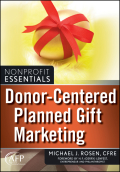
A fresh step-by-step guide for identifying your nonprofit's planned giving prospects and inspiring them to give generously Donor-Centered Planned Gift Marketing helps nonprofit organizations move beyond traditional marketing techniques that have historically yielded only modest results and reveals how putting the focus on the donor can produce the best outcomes for all. Here, nonprofitsnew to gift planning will learn to market effectively from the start while those with established programs will discover ways to enhance their efforts. Youwill learn about various donor-centered marketing channels and techniques, aswell as how to generate internal support for an improved planned gift marketing effort. *Full of useful and proven tips you can implement for immediate results * Offers practical tools including forms and checklists * Includes a worksheet to help organizations calculate their planned giving potential Sharing the latest research findings, this book shows you how to identify who your planned giving prospects are. You will learn how to effectively focus on them through meaningful communication that ultimately inspires them to give-and give more INDICE: The AFP Fund Development Series. Preface. Acknowledgments. Chapter1: Introduction to Donor-Centered Marketing Take Care of Donors: A Lesson from Aesop. Planned Gift Marketing for All Organizations. Percentage of Americanswith a Planned Gift. Five Common Myths about Planned Giving. There has Never Been a Better Time. An Illustration of Donor-Centered Fundraising. Proactive versus Reactive Planned Giving Stepping Stones to a Successful Planned Giving Program. Summary. Exercises. Chapter 2: Identify Who Makes Planned Gifts. Everyone is a Planned Gift Prospect. General Characteristics of Planned Givers. ThePriority-Prospect Equation. Factors that Impact Ability. Factors that Impact Propensity. Factors that Impact Social Capital. Pros and Cons of Information. Basic Prospect Data. Prospect Rating. Summary. Exercises. Chapter 3: Identify What Motivates Planned Gift Donors. Manipulation versus Motivation versus Inspiration. What People Want. Demographic Factors Impacting Motivation. General Individual Motives. Organizational Factors. Bequest-specific Motives. De-motivating Factors. Summary. Exercises. Chapter 4: Educate and Cultivate Planned Gift Prospects. The Need for Education and Cultivation. Create a Planned Giving Brand Identity. Fundamental Strategic Approach. Words Matter. Keep Messages Meaningful and Memorable. Existing Materials. Direct Mail.. Telephone. Newsletters. Website. Email. Social Networking Technology. Events. Face-to-Face Visits. Advertising. Summary. Exercises. Chapter 5: Educate and Cultivate ProfessionalAdvisors. Build Win-Win Relationships with Donor Advisors. Six Exchanges of Value. The Planned Giving Advisory Council. Defining and Evolving Roles. The Planned Gift Advisory Council and Its Members. Five Practices for Working with Donor Advisors. Summary. Exercises. Chapter 6: The Ask. Good Things Come to Those Who Ask. Using Direct Mail to Ask for Gifts. Using the Telephone to Ask forGifts. Meeting Face-to-Face for the Ask. Different Ask Scenarios When Meetingwith a Prospective Donor. Donors Make Marketing Recommendations. Summary. Exercises. Chapter 7: Stewardship. Stewardship Closes the Circle. Thank Donors Quickly and Frequently. Recognize Planned Gift Donors. Reporting to Donors. Internal Stewardship. Summary. Exercises. Chapter 8: Getting Started. Is Your Organization Ready? Getting Organizational Acceptance. Case for Support. Gaining Staff Acceptance. Building the Marketing Plan. Evaluating the Marketing Effort.Summary. Appendix 1 Planned Gift Program Potential Worksheet. Appendix 2 Bequest Confirmation Form. Appendix 3 Sample Internal Case for Donor-Centered Philanthropic Planning. GPD Academy. Appendix 4 Cost to Raise a Planned Gift Dollar Worksheet. Notes. Planned Giving Glossary. References. About the Author. AFPCode of Ethics for Professional Philanthropic Fundraisers. Donor Bill of Rights. Partnership for Philanthropic Planning Model Standards. Index.
- ISBN: 978-0-470-58158-2
- Editorial: John Wiley & Sons
- Encuadernacion: Rústica
- Páginas: 384
- Fecha Publicación: 03/11/2010
- Nº Volúmenes: 1
- Idioma: Inglés
